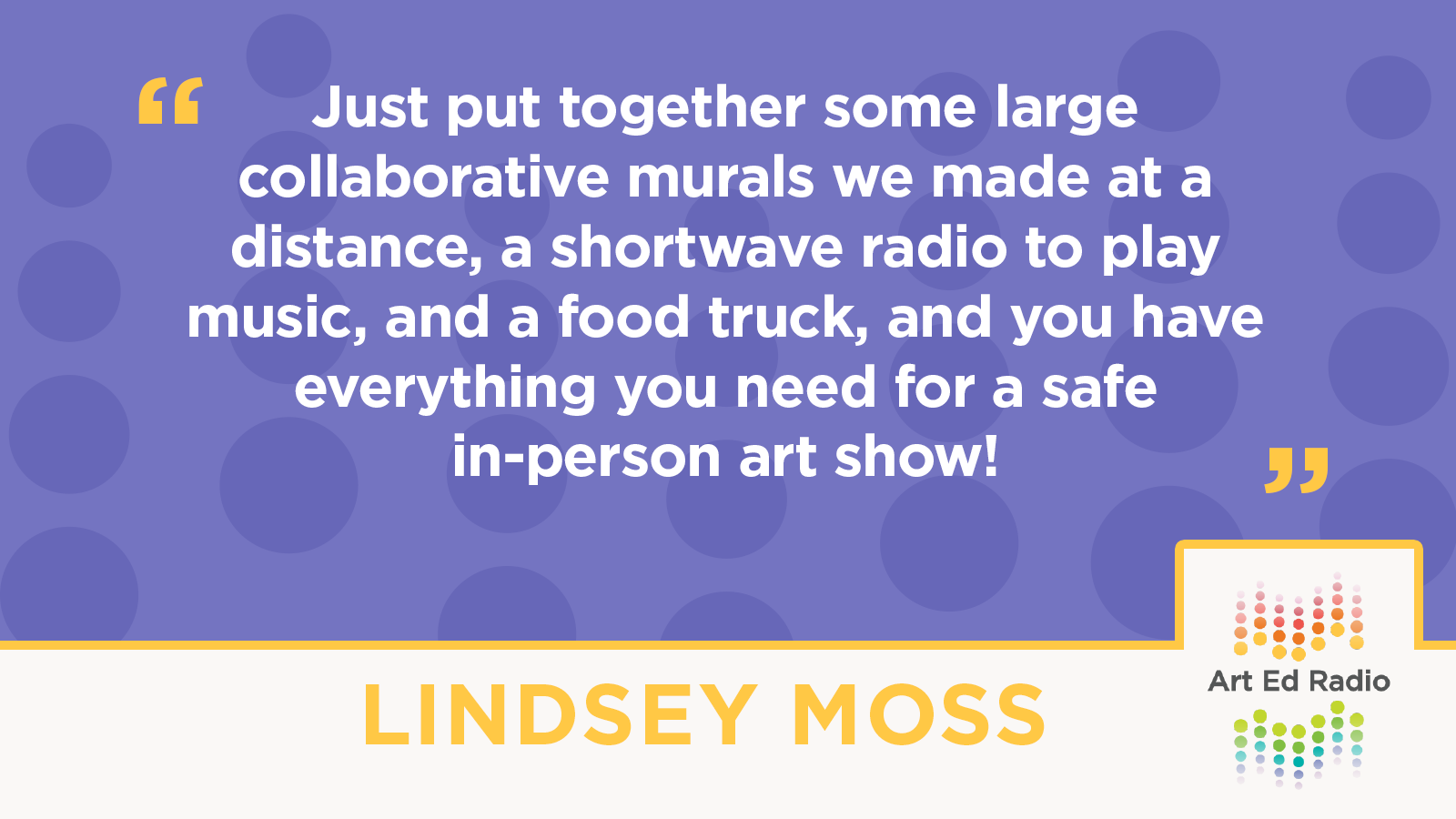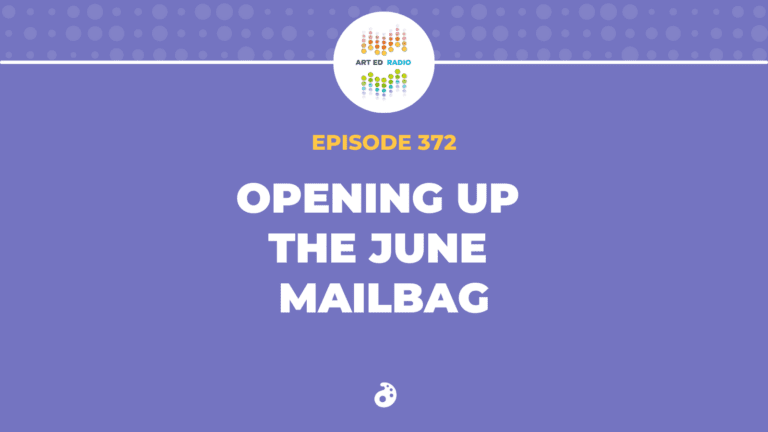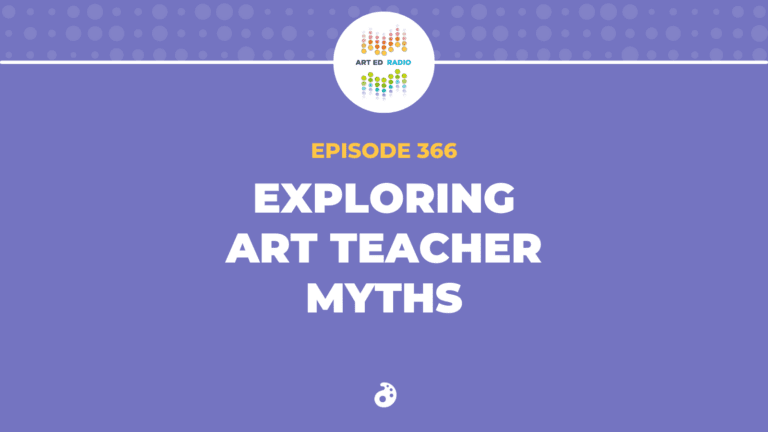We have heard about so many unique and creative ways that art teachers are putting together their spring art shows–so why not a socially distant drive-thru art show? In today’s episode, Lindsey Moss joins Tim to share her ideas for a collaborative, community-based art show that involves all of her students while keeping everyone safe from beginning to end. Full Episode Transcript Below.
Resources and Links

Transcript
Tim: Welcome to Art Ed Radio, the podcast for art teachers. This show is produced by the Art of Education University and I’m your host, Tim Bogatz. So as we know so many things this year have been incredibly different. We’ve navigated so many different things and now as we get to the spring time, it’s time for us to navigate art shows in a very different way. And I’ve been thinking about this a lot and actually Nic Hahn on Everyday Art Room just did a fantastic podcast about virtual art night with an art educator named Karen Nall.
It’s really interesting. I would encourage you to go listen to that and we’ll link to it if you want to check it out. But I wanted to get an on the action too. And my good friend, Lindsay Moss is doing something very creative with her art show this year. And I was actually going to spend some time explaining it, but I figured it would be so much better if she actually told you all about it and she’s already here waiting and ready to talk to us. So Lindsay, welcome back to the show. How are you?
Lindsey: I’m great. Thanks for having me, Tim.
Tim: Well, thanks for coming on and thanks for agreeing to tell us all about the super creative idea you have. So like I said, you can do it much better justice than I can. So to begin, can you just tell us a little bit about the art show that you’re in the midst of planning right now?
Lindsey: Yeah, I’m in the thick of it right now. We’re a couple of weeks out. I mean it’s the first week of May and so, every art teacher knows that this is stress crunch time. We will be ready. It’s like a wedding, it’s going to happen no matter what, we’re just going to push forward. But yeah, we’re having an in-person art show and to make it safe, we are doing a drive-through art show. So all of our families are going to attend the art show in their cars.
And the way I’m accomplishing this is each class is making a collaborative mural. And we’re socially distancing here at school. I live in Yorkville, Illinois, and Illinois recently went from six to three feet, but I still like to keep the kids as far apart as I can. So most of these murals are created collage style, where they make individual work for the mural and then I assemble it into the collaborative piece. So we’re making art apart together.
Tim: Nice.
Lindsey: Yeah. So we’ll end up with when this is all said and done 26 murals. They are on four-by-eight-foot wooden panels. And then we are staking them on both sides of our bus lane. And we’re using a short wave radio transmitter to transmit some audio and some music and people are just going to cruise on through about five miles an hour and see all the art at once. So needless to say, it is really different from every other show I’ve ever done, but my kids are super excited and it’s going to happen.
Tim: Nice. I have so many questions. This is such a spectacular idea, I want to ask so many things about logistics, but first big picture, where did the idea for this come from? Where did you get the inspiration to do a drive-through art show?
Lindsey: Well, like all good ideas, I was having drinks with a friend. My music teacher here at the building, Mike McHugh and I were sitting down talking about his music program is a big event, his holiday program is a big event here at school. And I’m super proud of how well attended my art show is. We have parking problems for the art show. And as we were looking at the year and what to do, we were trying to do some out-of-the-box thinking. And last spring when things were still super unsafe, our district really wanted to honor our seniors and they did a drive-in graduation ceremony. They had parking spaces marked off to keep the cars apart and they did graduation that way. The idea being that if people are in their car, they’re socially distanced from one another.
Lindsey: And Mike and I were talking and I got the idea of a drive-in movie. I thought, “They were able to record the music program and do it that way.” And Mike was like, “That’s great.” And that’s what he did and it was outstanding. That’s how we all saw the holiday music program this year. So then it just made sense to do it for the art show. We have a model that works with people in cars, but then I had to rethink the art show because parents are used to coming and seeing two to three pieces by their kid that are usually 12 by 18 or smaller. But if you’re in a car, you can’t see that at a distance, and that’s where I hatched the idea of these large collaborative murals, because they’re visible from a car. And I also feel like these kids have had so much time apart over the last year that making something where you’re relying on your classmates and other kids to make it really whole is a neat theme. And so, it’s been good so far.
Tim: That’s cool.
Lindsey: That was how it hatched.
Tim: Yeah. Okay. So I guess now I want to talk, since you just mentioned it, about these big four by eight murals that are used. You have how many of them you said? 26?
Lindsey: We’ll have 26, yeah.
Tim: Oh my goodness. So can talk us through the process of creating? What does one look like? What will the finished product look like? How does each kid play a part? How does it all come together? Can you just talk us through that whole process?
Lindsey: Sure. So I had to rethink all the standard projects that I had annually in my art shell. You have things that change every year, but then you have those couple oldies, but goodies everybody’s expecting to see and again, that format isn’t working. So I realized that it needed to be large scale. You have to be able to see it from a distance. And also, it needs to be something where the works maybe are great on their own, but when it all comes together into something larger, that’s when you really have this synthesis that makes it amazing. So I decided for a theme I would just go with art history, because that’s recognizable to a lot of people because again, they’re in their cars. You can’t have conversations with them, those normal advocacy conversations can’t happen. So they have to know what they’re looking at, right?
So I started making a list of famous and contemporary artists, trying to include a lot of diverse artists too. And I thought, I’ll assign one per class and then I realized pretty quick, you need that, because you don’t want one topic per grade level and people are really looking at seven things. That’s not worth it to drive, right? But that volume of artists and lessons is pretty daunting. I’m friends with Sarah Kay, the art room glitter fairy, so I called her up and told her the idea and she wanted to try it too. She was an excellent sounding board. We Zoomed for a really long time talking about potential lessons and she helped me come up with a lot of creative ideas. So it’s things like if a class studied Monet, everyone made a water lily or dripping ivy and it all assembled together to be the Japanese Bridge.
We had a really cool Mary Blair one where everybody did different [inaudible 00:08:06] all assembled to be some of those iconic images from It’s A Small World. Things like that, where a piece isn’t really a piece until it’s with the whole thing. And pretty much everything they did had to be on paper because I can’t have them painting on the mural next to each other because that defeats the whole purpose, right? So it’s something that they were creating at their desks while spaced 6 feet a part, and then they hand it all to me. And then I’ve been a flurry of individual getting it all onto these collaborative panels. So I’ve gone through a lot of spray adhesive. It gets pretty windy here because we’re outside Chicago, so everything has to be down pretty well.
Tim: Yeah, yeah. Now you said these are all on four by eight panels. So can you talk a little bit, I assume those aren’t cheap. Can you talk a little bit about money that this has cost, but also just support from your administrator, from I assume you’re having custodians help you put these up. Where do you get a short wave radio? How does that all come together? Who all has helped you with this?
Lindsey: Well, I have a really good support system here. Some of my best friends work here at the building and then my principal Michelle is amazing. So when I walk in and try to explain this idea, great, let’s do it. And then, the money, this is expensive because each panel, like I said, they’re four by eight and I got them at Menards. I don’t know if that’s regional, but it’s similar to Home Depot. They’re thin, they’re, I would say about an eighth of an inch thick there because I can’t move them otherwise they’d be far too heavy. And those panels, I think are about $16 bucks a pop. The more expensive part of it is maybe the stakes to get it into the ground. We’re using fencing posts because like I said, wind is a real factor here.
But the financial part of it fell together because the weird thing about this year is there’s not a lot going on. A lot of things have been canceled for schools and school districts and normal events have been canceled. So for example, when I approached the PTO about this, they had a lot of money in the budget. They had a fundraiser, but they can’t run their normal fall fest or all these other things. So they were basically like, “Great, let us know.” And then, my budget is interesting too because I’m a clay person but I’m on a cart. So we’re still doing ceramics, but not the volume that we normally do, so that’s a lot of money saved in glaze. So you start to look at your budget and realize, “Wow, I didn’t buy as much this year in terms of printmaking or ceramic supplies as normal and there was money leftover.” So I didn’t really have to do fundraising for it, I just asked a couple of sources and got the funding that way.
Tim: And then has this been a big drain on you personally, as far as figuring out all the logistics, shopping for giant panels, putting all the work together, displaying that? How much time are you spending putting this together?
Lindsey: Yeah, it is a little different than the normal art show because I think being on the cart is maybe part of that because when you’re in your room, you don’t realize how many times a day in the month leading up to the art show you’re stealing 5 minutes or 10 minutes somewhere to get this random task done or sort things or get organized. And I have really felt that over the month or so, how I’m just not really ever in the art room. So that part of it has been daunting. But again, going back to this idea how there hasn’t been a lot going on because of the pandemic, a lot of these normal school functions have been canceled. People want to help. My principal volunteered to come in on a Saturday and help flat paint the boards.
Tim: Wow.
Lindsey: I know. Because people are excited to get involved. I think it’s also important to know that my kids go to school here. So I’m really invested in the whole student population here. I’ve known them since they were little, both as students and friends of my children. And I’m really invested in trying to make good memories during this time. And then, Mike and I were talking, my music teacher, the other day about how the pandemic has been personally so hard for us as teachers. We feel like we’re treading water and trying to survive it, right?
But we don’t teach math where you just put your head down and plow through the curriculum. Our message to kids is art is something that heals art, is something you’ll have your whole life. You can count on art when you’re down. So this isn’t the time for me to put my head down and hide. This is my time to make it matter for them. But yeah, I’m up to three cups of coffee a day. I will make it, I will make it to May 4th, Tim.
Tim: We know you will. We know you will. Now you said that a lot of people that work there are super excited about this, does that apply to your kids as well? I assume they’re really thrilled to be part of this, to be creating this. But what has student reaction been when you first told them about the idea? And then what has it been like as they’ve been working and developing these plans?
Lindsey: Well, it’s funny because the art show is a staple event for school and when I told them that we weren’t going to do online we were still going to try to do it in-person, they were so excited, overwhelmingly. And we just entered quarter four here in Yorkville and at each quarter, parents have the opportunity to change learning modalities. So we had a lot of kids who had been e-learners coming back to the classroom and I walked into a classroom on Tuesday and there was a first grader I hadn’t seen since last year when he was in kindergarten and my art show was in January last year, so he was there and I walked in and I was like, “Hey Kyler, how you been? Do you remember me? It’s Mrs. Moss.”
And he goes, “Wait, did I miss the art show?” And I was like, “Well, no buddy, you didn’t miss it but it’s going to be outside.” And I tried to explain the whole thing to him, he goes, “So it’s better than last year?” I do feel like I have forgotten though to share a pretty crucial aspect of this, that my PTO is running a food truck rally in the front parking lot simultaneously.
Tim: Oh, wow.
Lindsey: So the idea is the advertising says, “Come for the art, stay for the dinner.” So a lot of my kids are excited to be in the show, but also there are tacos.
Tim: That would get me there, to be honest.
Lindsey: Yeah, right.
Tim: So what do you expect from the night? Are you assuming that there’s going to be a big turnout? What are you looking for? What are you preparing for?
Lindsey: Yeah, it’s really hard to know because I always did the art show earlier in the year, January, February, because I don’t want to be competing with sports because I feel like it’s between me and baseball, I’m going to lose unless it’s a really hardcore art kid. And so, I always ran it really early in the year and that worked for me. We had massive participation, parking problems, the parking lot was full, people were parked out on the street, it was a big deal. So it’s hard to know if we’re going to ride that wave of enthusiasm or get stuck with spring sports. I don’t know. But the kids I’ve talked to, it seems like a lot of people are going to come. I think the food trucks are helping. So I’m cautiously optimistic, although it is 2021, so I feel pretty confident it’s going to rain.
Tim: Right. Okay, I was going to ask what the backup plan was if you run into inclement weather.
Lindsey: The art show is set for Tuesday, rain day is Thursday. But I think in my mind, I just expect that it’ll be Thursday.
Tim: And then I guess my last question for you and you probably don’t have an answer for this yet, I guess, but do you think this is something that you might repeat in the future? Has this been fun? Has it been worthwhile? Are you just looking to getting back to normal next school year?
Lindsey: Well, it’s funny you ask that because there is something different about this that I like, because in a normal art show, people come see artwork that they’re about to get back in a portfolio. You come see a piece of art that your kid made and in a few months, or weeks or whenever it’s scheduled, you’re going to end up with that same piece of artwork that you can physically hold and frame or put on your fridge or whatever. This is the only time you can see this because things are shellacked to wood and the kids all understood they wouldn’t get this back. And also, they don’t work well independently, one waterlily is great, but when it’s part of the huge bouquet, it’s something transformative, right?
So it’s cool that it’s this event or this thing that people can come see that they otherwise can’t see. My principal had this great idea, we’re going to photographs of each one and QR code them and then pass out a paper. So people have a photograph of all of them after they leave, access digitally but I like that. And then I’ve been trying to wrap my head around if we did it this way every year, I think it would always be easier than this because if I was in the art room I could be playing with things, organizing artwork all the time. So I don’t know. I love my old art show, but this one, it’s cool.
Tim: Nice. Well, how about this? We’ll check back in, in about 10 months and just see what you’re thinking.
Lindsey: Okay. Fair enough.
Tim: Oh, cool. Well Lindsay, thank you so much for taking the time to chat with me and just sharing everything that you’re doing. I think this is an awesome idea and we are wishing you the best of luck in a few weeks here.
Lindsey: Thank you very much, Tim.
Tim: Before we go, I want to tell you about the Art of Education University’s newest course, innovation through design, where you can explore how to use design thinking to help your students solve complex problems in and out of the art classroom. In this innovative course, you will infuse the five stages of design thinking into your art curriculum and instructional practices, expanding your current practices to include human-centered, creative and playful experiences for collaborative learning. After analyzing case studies from art teachers experienced in steam maker spaces and project-based learning, your toolkit will be bursting with new ideas for practical application at any level. If this is something that interests you, the first course will start at the beginning of May, but you can sign up now.
We will link in the show notes and you can go to theartofeducation.edu/courses to learn more. Now, as I said at the beginning of the episode, as I intimated with Lindsay, doing an art show like we discussed is not for everyone. We don’t all have that budget or that level of support whether from administration or our colleagues or our community. Lindsay is frankly in a great position. But my hope is that this might spark an idea or a burst of inspiration, something that might work for you. Maybe that’s a new way of doing collaborative work, a new way of displaying, a new way of connecting with your students or with your community. And even if none of that comes to fruition, we can just take a second with today’s conversation and appreciate a teacher who is doing something great.
Art Ed Radio is produced by the Art of Education University with audio engineering by Michael Crocker. Thank you for listening and good luck with your art show, whatever it may look like this year and we will talk to you next week.
Magazine articles and podcasts are opinions of professional education contributors and do not necessarily represent the position of the Art of Education University (AOEU) or its academic offerings. Contributors use terms in the way they are most often talked about in the scope of their educational experiences.



